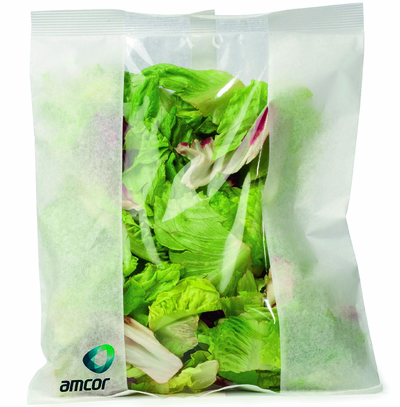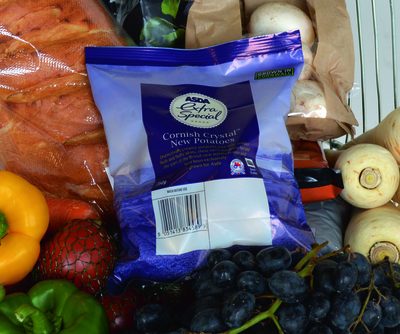Viridiflex compostable MAP solution for Asda own-label potatoes (Ultimate Packaging)
However smart the software or efficient the equipment, the products of their combined expertise will only be as good as the substrates they are printed on, reports Des King.
New material developments rarely capture the same sense of excitement as, say, the introduction of a new press or the development of an intuitive colour management software program. Yet the plastic film or paper laminate on which they interact is the most substantial element of the finished pack, not to mention the highest proportion of its total cost.
It is quite clear – indeed, often transparently obvious – who are the shining stars in the flexible packaging firmament. With an inviolable 73%share of the European flexibles market, increasingly innovative film applications (in the main PP or PE based) are predicted to generate sales worth almost €38 billion by 2016 via a five year 13% growth rate according to Smithers Pira.
New resin developments
Whether blown for greater strength or else cast into biaxially oriented PA (BOPA), polyamide nylon (PA6) provides optimum barrier protection against oxygen in co-extruded structures and is especially appropriate for the packaging of fresh produce, meat, fish and cheese without recourse to the unnecessary use of additives.
PA6 now accounts for over 10% of global life and material sciences producer Royal DSM’s total business, notably via its portfolio of Akulon resins. This has recently been extended through the introduction of a new XS grade that directly addresses conformity issues that can occur in multi-layer structures by crystallising more slowly than conventional PA6 to create a more stable bubble and give processors more leeway in their processing conditions.
The resultant film is also more stretchable, so less force is needed to achieve the same blow-up ratio (BUR), or the same force can be used to produce a bubble with a BUR between 7% to 10% higher. There are also fewer wrinkles in the flat film.
Even though slower crystallisation creates larger crystals that might be expected to produce a less clear film, tests on full-scale production lines have shown that there is virtually no discernible difference in the optical properties of films made with a benchmark film-grade polyamide and Akulon XS. In fact, all properties of the film in use are the same as in film made with standard PA6.
‘Packaging plus’
Amcor Flexibles is in some respects, a converter with integrated extrusion, buying in films be it commodities or specialities whenever it makes sense, but with a clear preference to develop solutions in house wherever possible.
A key area of focus is the ongoing supply of solutions for the fresh and dairy category where it first established its industry benchmark ‘PPlus(R)’ customised permeability film technology over 20 years ago.
‘The principal driver behind this initiative has always been to reduce spoilage during transportation as well as in store by allowing fresh produce to respire in the packaging at an appropriate rate to prolong its life expectancy and reduce waste,’ noted Fresh, LED, dairy and capsules communications manager, Karen Quirchove.
‘The inclusion of food technologists within the packaging development team ensures that applications are both tailor-made and technically fit for purpose.’
Amcor has recently introduced its new paper laminate ‘Panorama’ concept aimed at extending enhancing on-shelf fresh appeal of fresh fruit and vegetables, cheese, cured meat, etc, and optimising brand communication via vertical form fill seal (VFFS) and pre-formed bag applications incorporating a tailored window and a wide range of paper options which afford a high level of printability.
Also engineered to extend the shelf life of fresh produce is the new ‘Packpyrus’ thermoformable cellulose-based flexible film solution, whose high oxygen barrier properties make it ideally suited to fresh products such as sliced meat and cheese. In addition to outperforming traditional PA/PE and APET/PE/EVOH solutions, the use of renewable fibres not only reduces overall carbon footprint by as much as 70%, but also enables it to pass through the waste stream in a number of countries, including France and Belgium for eventual recycling.
‘Whenever Amcor develops a new film solution or replaces an existing one for a customer, there is a clear focus upon how it can improve sustainability,’ said Ms Quirchove. ‘The new N-Gage concept is a good example: a price-competitive proprietary film that offers substantial sustainability benefits with a potential to reduce pack weight up to 35% and cradle to gate carbon footprint by up to 10%.’
 Panorama paper laminate film (Amcor Flexibles)
Panorama paper laminate film (Amcor Flexibles)
Seal or re-seal
Many of Amcor’s newer concepts can be delivered with the added benefit of P-Plus technology, such as Reclose lidding films that can seal to PE, PS, PP, or directly to APET; the reclosable solution maintaining integrity over 15 separate times of usage.
Secondary sealing applications, however, still maintain a significant market share. German skincare brand owner Beiersdorf’s wholly owned UK subsidiary tesa has recently extended its range of adhesive tape solutions via the introduction of a secondary ‘Lift & Reseal’ residue-free finger lift system that is being steadily adopted by a number of food producers and retailers.
The tape’s robust adhesive allows the packs to be opened and reclosed at least 20 times without leaving any messy or unsightly residues. The adhesive mass will not discolour and packaging keeps its perfect look for up to 24 months.
The system comes with an inline dispenser/applicator (installed free of charge and fully operational within 24 hours) which delivers the spool wound tape directly to pack; unwinding in a controlled way with a brake and buffer system for maximum speed and efficiency.
Greener options
The bulk of conventional oil-derived film supply is technically hugely competent but as a high volume market predominantly cost-driven. Conversely, bio-based alternatives – often enhanced through proactive manufacturer and converter collaboration – whilst only representing a fraction of the flexibles market are more geared to capturing brand owner imagination if not necessarily investment.
Despite its output of 90,000 tonnes of conventional OPP film outweighing the annual production of its compostable cellulose-based NatureFlex (30,000 tonnes) by a factor of three times, Innovia Films is a prime mover in this respect with a stated commitment towards initiating joint development projects across the supply chain, said business development and sustainability manager, Andy Sweetman.
‘The strategy is to work with partners who are motivated to put constructions together; it takes time, it takes some investment but it is a very effective way of getting the bio-based proposition out there.’
A case in point is the dovetailing of NatureFlex with Sappi’s Algro (gloss) and Leine (uncoated) compostable papers in weights of between 40-80 gsm to produce a viable alternative for oil based paper/polyolefin laminates currently being used for a wide range of flexible packaging applications including confectionery and snack wrappers, stand-up pouches, sugar sachets, pharmaceutical packs, etc. According to Innovia, packaging using these papers will meet the EU Packaging Directive, which comes into force in 2014.
Whilst hitherto the onus has been largely on the converter to combine film and laminate, both manufacturers are clearly hoping that the ready availability of a ‘one-stop solution’ will drive a switch across from oil to biobased plastic. A further collaboration recently announced is with the Netherlands PLA supplier Corbion Purac to develop a high temperature resistant transparent compostable film that would be suitable for food applications requiring thermal stability during processing or in use, such as soup and hot drinks.
Meanwhile, working direct with the converter is the more conventional route towards developing specific solutions. For example, Parkside Flexibles’ new flexo printed metallised laminate (EN13432 accredited) for applications requiring an oxygen and moisture barrier.
Collaboration
Arguably the most potentially rewarding co-development project aimed at boosting retail and brand owner awareness to the capability of compostable applications is the linkup between Innovia and NE based flexible converter, Ultimate Packaging. Branded as ‘Viridiflex’, the multilayer construction combines NatureFlex with an unnamed film and a compostable adhesive to produce a moisture-permeable MAP solution for fresh produce.
‘They’re deliberately creating a pack type that hasn’t existed before,’ enthused Mr Sweetman. ‘All that we do in plastics is about delivering barriers; they are doing the exact opposite and for the very legitimate technical reason of evaporating excess moisture. We make films with interesting base properties; it is the converter’s magic that makes them work.’
Key to Viridiflex’s enhanced performance is the converter’s patented laser perforation technology (Adapt MAP), said Ultimate’s marketing manager, Lauren Whittaker. ‘The film’s excellent oxygen barrier qualities help to keep the moisture away and prevent mould, whilst the perforation patterns regulate the gas transmission.
Whilst cost is maybe three times higher than for a conventional pack, the trade-off is maintaining a fresher product that enjoys a significantly extended shelf life; greater satisfaction for consumers and less wastage and complaints to be handled for retailers.’
First to adopt the Viridiflex solution was Asda for its own-label Cornish Crystal Potatoes over a limited period during August and September. ‘Our customers have benefited from a significant increase in product life and end of life product quality, highlighted by a 92% year on year reduction in complaints in the first five weeks of the in-store selling period,’ reported produce category technical manager, Jon Wynn.
Ultimate is now setting its sights on ensuring the freshness of two staples of the traditional Christmas dinner, said Ms Whittaker. ‘According to sprouts suppliers they could pack the produce in almost anything in the middle of their season and it would be OK, but at the beginning and end when the vegetables are really delicate they need to go into a pack that extends shelf life.
‘Trials being undertaken with packer fillers show that the on-shelf life expectancy of sprouts can be extended from the statutory two to as long as 15 days in a Viridiflex pack. Parsnips also do better; our solution keeps them looking white for a good week even when the top has been chopped off compared to the yellowing effect via a conventional pack.’






